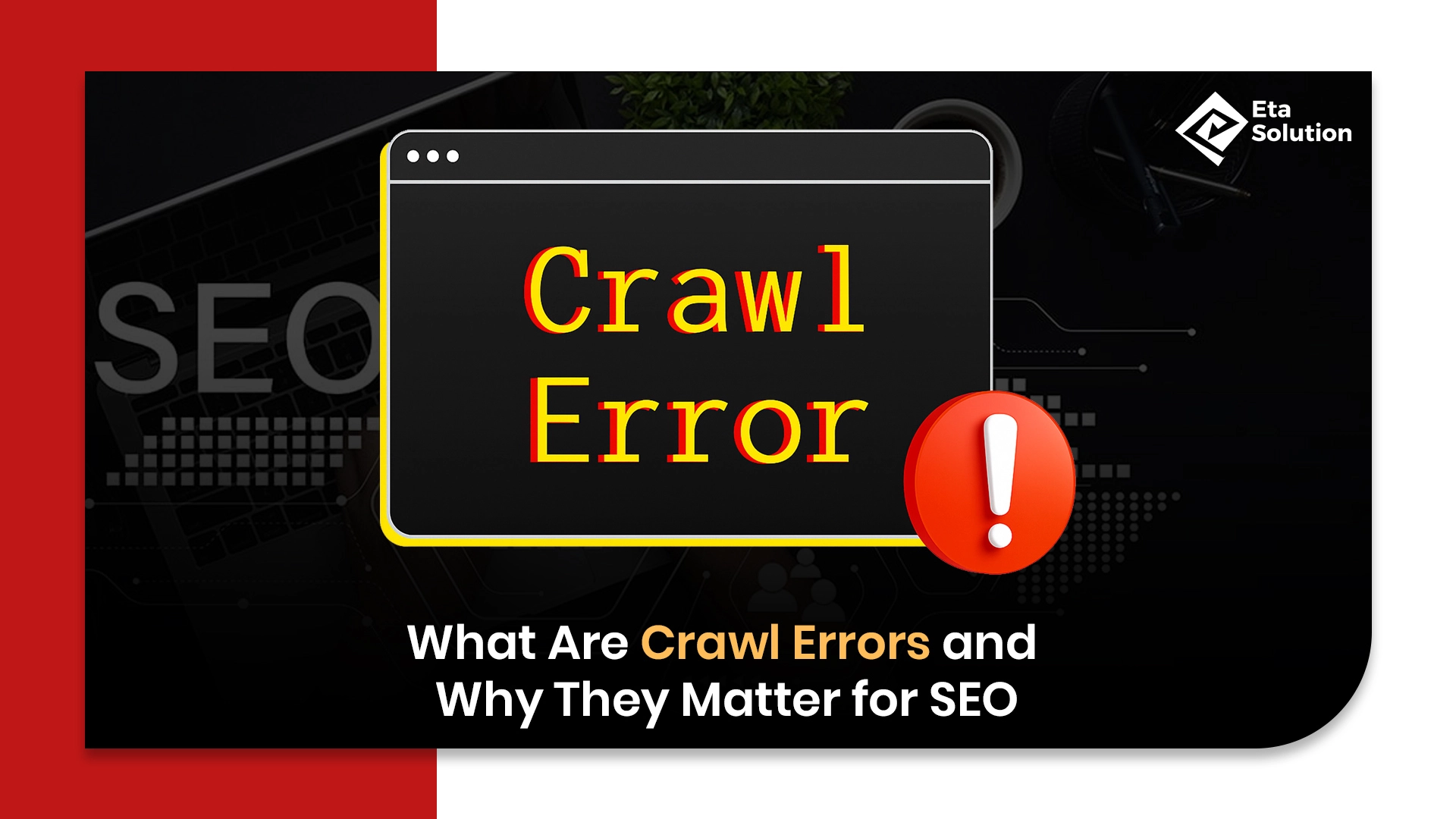
Understanding Crawl Errors SEO
Conceivably you have created a very appealing storefront, loaded it up with desirable products, but the lock is broken and the door keeps closing on people who come to visit. Basically, a crawl error meaning leads to the bot tries to get into your site, but the door is either closed, blocked, or redirected. If we simplify it even more, crawl errors are situations in which a crawler is given a URL that it cannot access or index.
Such problems make a difference because un-crawlable pages are not indexable and thus, if they are not indexed, they will not be available in search results.
What the industry secrets reveal is that around 25% of websites are said to have issues with crawlability caused by internal linking or robots.txt errors.
So, recognising crawl errors isn’t optional, especially if you’re seriously focusing on the long game.
Types of Crawl Errors – URL Errors vs Site Errors
Let’s divide them into two neat buckets so strategy becomes obvious.
Site Errors:
These affect your website as a whole: entire domains or big sections where the crawler simply can’t get access. Examples:
- DNS errors – domain name resolution failure
- Server errors where the server fails to respond or times out
- robots.txt or other blocking rules that accidentally shut down large parts
URL Errors:
These are more localized: specific pages the crawler fails to fetch. Examples:
- 404 “Not Found” errors – page removed, no redirect
- Soft 404s – page returns 200 OK but shows no content
- Redirect loops or chains that trap the crawler
- Broken internal links that lead the crawler down dead paths
Understanding these two categories helps you prioritise: site-errors are higher risk, URL-errors are more surgical but still dangerous.
How Search Engines Work: A Visual Breakdown

Common Causes of Crawl Errors
Why do they happen? Because the web is messy and nothing stays perfect. Some of the main triggers:
- Hosted outage or slow server response → leads to server errors.
- Internal link structure not updated after page removals → crawler follows links to nothing.
- robots.txt misconfiguration or blocking valuable resources that the crawler needs to render the page.
- Sitemaps listing old or deleted URLs.
- Redirect errors that confuse crawlers.
The probability of crawl errors increases with the enlargement of sites if the site architecture is not managed proactively.
How Googlebot and Other Crawlers Work
In the engine room:
- Crawlers are basically a team that comes to inspect your place, and they notice links, they go after those links, they bring the pages, they comprehend them, and in the end, they record them.
- Firstly, they look at your robots.txt to find out the parts that are open. If the fetching of robots.txt is not successful, crawlers could decide to quit their work or carry it out partially.
- They employ what is known as a “crawl budget” – the number of pages they are allowed to crawl within a certain timeframe on your domain. If there are too many situations where they cannot proceed, then the budget is wasted.
- The rate at which a crawl is performed and new content is fetched depends on factors such as the health of your website, the speed at which changes are made, server speed, and the authority of the links, etc.
In cases where crawlers are hindered or are running out of resources while looking for broken link SEO, your quality content can be invisible for a longer period of time than it should be.
How to Identify Google Search Console Errors
Since you are interested in actions that lead to results:
One can, through the use of the tool Google Search Console, do the following:
- Use the Coverage report to find the pages that have not been indexed and the reasons for that.
- The Crawl Stats report allows you to find out the last time the crawlers came, the request count, errors, server responses, and so on.
- If you need to check a specific URL, you can use the URL Inspection Tool to locate the local crawl site indexing issues for that exact address.
- Observe the time for changes in the case: a sudden increase of errors or a significant decrease of crawl is normally showing that something has broken.
If you’re working with a firm like an SEO company in Ahmedabad, they should be providing you with these reports and interpreting them for your site.
Impact of Crawl Errors on Website SEO Performance
You could invest heavily in content, on-page SEO, and link building, but if crawlers can’t read your site properly, you’ll see diminished returns. Some specific impacts:
- Pages with crawl errors may never get indexed, so no traffic from search engine visibility.
- Internal link equity gets broken when links send crawlers into error states or loops.
- Wasted crawl budget: a crawler’s job to go through broken pages consumes the time that could be allocated to valuable pages.
- In response to your website having too many error pages, search engines may consider it to be of low quality and, as a result, will decrease the frequency of their crawl or the level of their priority.
- Eventually, slower changes in the index, lower positions, and fewer sales are the consequences. A lot of websites are unaware that the technical gap is so deep until it is too late.
One source said, “crawl errors kill visibility: If search engines can’t index your pages, no amount of content will help them rank.”
So if you’re working with a serious SEO company in Ahmedabad, they should be showing you not just “traffic up” but “crawl error down” as a KPI.
How to Fix Crawl Errors
Here are pragmatic fixes:
- For 404 crawl issues: if the page moved, set up a 301 redirect; if it’s permanently gone, remove internal links and update the sitemap.
- For server error SEO: check hosting environment, monitor server performance, fix high load or timeouts, ensure your site responds reliably.
- For URL crawl problems like redirect chains: collapse them, route directly from source to final destination, avoid loops.
- For robots.txt or blocked assets: audit your rules, whitelist essential CSS/JS/images so crawlers can render pages.
- For sitemap issues: ensure your XML sitemap lists correct, canonical URLs only; remove outdated entries.
- Run regular log-file or crawl-audit tools to uncover hidden issues before they escalate.
These actions will significantly improve your site health SEO and support website crawling and indexing.
Best Practices to Prevent Crawl Errors
Preventing is better than firefighting, yes, even I believe that. Here’s what to embed into your routine:
- Keep sitemaps updated and accurate. Submit to Search Console, monitor for errors.
- Ensure your internal links and navigation reflect the current structure. When pages are removed, update links.
- Monitor server performance and uptime. Ensure hosting is scaled appropriately.
- Use canonical tags, avoid duplicate content.
- Limit unnecessary low-value pages that eat crawl budgets.
- Schedule a technical SEO audit to catch new issues.
With these habits, you’ll reduce the risk of crawl disasters before they hurt visibility.
The Role of XML Sitemaps and robots.txt in Crawling
XML Sitemap:
For the search engines, the map that you provide is the one by which they understand “these are the pages that I deem to be the most significant.” If your sitemap is out of date, the crawler can decide not to access your top content or continue to check the broken links.”
robots.txt:
A gate-keeper. It shows which parts of the site the bots can access. In case you have it set up wrongly, you might be shutting out the areas that are most important or creating places where the crawlers will have a hard time accessing your site.
These two instruments perform conjointly:
Sitemap offers the framework, robots.txt grants the rights. At a mismatch between them, you will usually find the errors in the crawl that are the most divergent.
How Regular Crawl Audits Improve SEO Health
Crawl Audit is the same as a check-up for your site: early symptoms of diseases are found, thus later, bigger problems are avoided. Forums say:
“While we are concentrating on how easily Google can crawl and index pages, we are putting aside the heavy influence of technical errors on user experience”.
Regular audits make you present not only as a reaction to traffic drops, but rather as a maintenance team ensuring site integrity. It is especially important if your business is expanding, frequently adding content, or redesigning. A reliable Best SEO company in Ahmedabad should be willing to provide such audits as a part of the service bundle.
Closing Take
If you had only one point to understand today: a website may have great content, smart backlinks, and an attractive design, and still not be able to rank in search due to the fact that crawl errors are blocking the entryways. As business owners, marketing managers, or CEOs who focus on ROI from organic search, you must consider the management of crawl errors not as a single intervention but as a continuous risk mitigation strategy.
Now I’ll leave you with a question to chew on: If search engines are blocked from your site’s doors even once, how many opportunities might you be missing without knowing?
When you next evaluate your digital investment, ask whether the door is open, not just whether the display is attractive.
Common categories include:
4xx client errors (e.g., 404 Not Found): URL doesn’t exist or was removed.
5xx server errors (e.g., 500 Internal Server Error): server failed to respond properly.
DNS errors: the domain cannot be resolved.
Timeouts / connection reset: the server is too slow or drops the connection.
Robots.txt or blocked resources: bots are prevented from accessing important files.
Each type has different causes and fixes; identifying the category is the first step.
Tools can surface and help manage errors but rarely fully automate fixes. Useful functions:
Search Console: lists errors and affected URLs.
Site crawlers (e.g., Screaming Frog): bulk export of problematic URLs and redirect chains.
Log-analyzers: match bot activity to server responses for prioritization.
CMS or server-side plugins: can auto-create redirects for renamed pages or detect 404s and suggest fixes.
Combine automated detection with manual review — automated fixes must be checked to avoid incorrect redirects or unintended indexing changes.
Enable alerts from Google Search Console and check Coverage regularly.
Monitor server uptime and response times with a monitoring service.
Schedule regular site crawls with a crawler tool and review reports for new 4xx/5xx issues.
Keep an eye on logs for spikes in bot errors and set alerts for abnormal patterns. Consistent monitoring catches errors before they cause major SEO damage.
Prioritize by impact:
Errors affecting high-traffic or high-conversion pages.
Errors on pages with many inbound links (link equity loss).
Sitewide errors (DNS, robots.txt blocking, server outages).
Recurrent or growing error patterns (sign of systemic issues).
Use analytics and server logs to rank by traffic and conversions, then start with quick wins that restore user experience and indexing.
Crawl budget is the number of pages a search engine will crawl on your site within a period. Sites with many errors or deep redirect chains cause bots to waste their allocated budget on useless pages, meaning important pages may be crawled less often. Minimizing errors, fixing redirects, and using sitemaps help ensure crawlers focus on high-value pages.

What started as a passion for marketing years ago turned into a purposeful journey of helping businesses communicate in a way that truly connects. I’m Heta Dave, the Founder & CEO of Eta Marketing Solution! With a sharp focus on strategy and human-first marketing, I closely work with brands to help them stand out of the crowd and create something that lasts, not just in visibility, but in impact!

Industrial Product Marketing with LinkedIn & Paid Ads

Top Digital Marketing Strategies for Industrial Products in 2026

B2B Product Launch Strategies: From Pre-Launch to Go-To-Market

